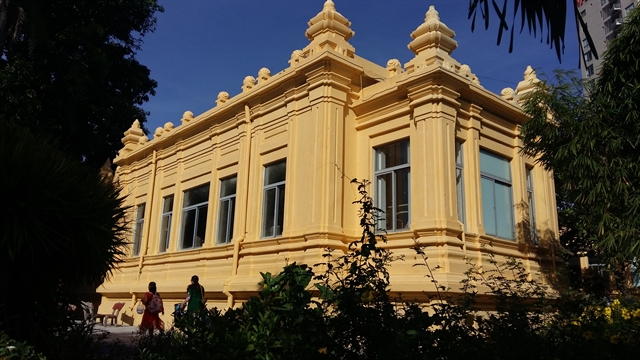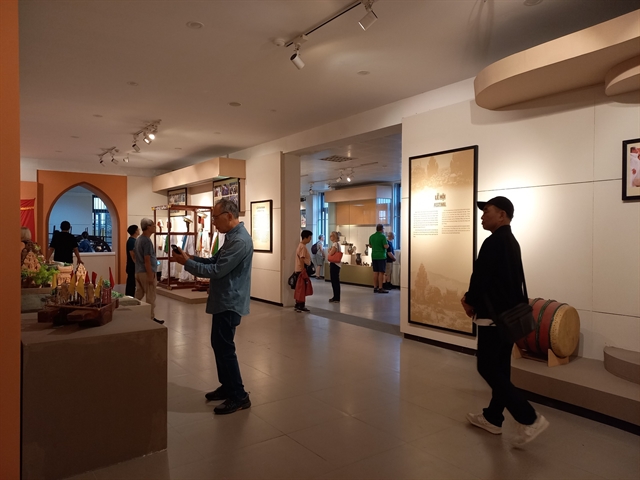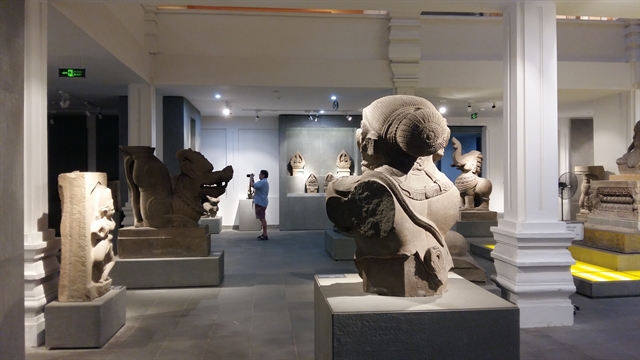
The Museum of Chăm Sculpture of Đà Nẵng is on the west bank of the Hàn River. The museum has been recognised as a historical relic site of the city. — VNS Photo Công Thành
ĐÀ NẴNG — The Museum of Chăm Sculpture of Đà Nẵng has been recognised as a historical relic site of the city, as it opens the Chăm Culture showroom creating diversified exhibits and arts space for tourism attraction.
The museum said the recognition show the local government's high appreciation of the value of the most visited site in the tourism hub, featuring a unique display of typical sculpture and artworks of Chăm Culture from the 5th to 15th century.
The museum, situated on the west bank of the Hàn River, was built in late 1915 with a big contribution from Henri Parmentier, a prominent archaeologist with the L’Ecole Francaise d’Extreme Orient (the Far East Archaeological Research Institute) in Hà Nội.
In mid-1919, he published the first catalogue of the museum, marking its inaugural ceremony.
It also features the history of Chăm towers, artefacts and French (20th century) architecture along with the development of Đà Nẵng City.
The museum still preserves and display thousands of artefacts and sandstone statues found at many Chăm towers and excavations from the Sa Huỳnh Culture (between 2,500 and 3,000 years old) in the central region.
Many ceramic fragments, sandstones and bricks that were excavated at the 1,000-year-old Chăm tower site in Đà Nẵng are on display at the museum.

Visitors tour the newly opened Chăm Culture showroom of the Museum of Chăm Sculpture of Đà Nẵng. The museum hosts 200,000 tourists per year. — Photo courtesy of the Museum of Chăm Sculpture of Đà Nẵng
Six national treasures have been preserved and kept at the museum for public display including the Trà Kiệu Pedestal; the Mỹ Sơn E1 Pedestal; statue of Tara/Avalokiteshvara; the Đồng Dương Pedestal, and two sandstone statues – Ganesha and Gajasimha.
Ganesha, one of the best-known and most worshipped deities in the Hindu pantheon, is readily identified by his elephant head. He is widely revered, more specifically, as the remover of obstacles; the patron of arts and sciences; and the deva of intellect and wisdom.
The statue of Ganesha was excavated in 1903 at E5 tower of the Mỹ Sơn Sanctuary in Quảng Nam Province by a group of French archaeologists. It has been stored by the museum since 1918.
Gajasimha is a mythical hybrid animal in Hindu mythology, appearing as a sinha or rajasiha (mythical lion) with the head or trunk of an elephant. It was found at the Mẫm tower in Bình Định Province in 1933-34, and displayed at the museum from 1935.
The museum offers an audio guide for tourists in 14 languages via smartphones, and a 3D experience in the four main rooms – Trà Kiệu, Mỹ Sơn, Đồng Dương and Mẫm tower.
All artefacts and exhibits were scanned to allow visitors to explore the museum in Vietnamese and English.
The museum and the Southeast Asian Art Academic Programme, School of Oriental and African Studies, University of London, launched the English-language book titled Vibrancy in Stone – Masterpieces of the Đà Nẵng Museum of Chăm Sculpture, providing a collection of high-quality photographs highlighting the museum’s attractions to mark its 100th anniversary.
The museum hosts around 200,000 visitors annually.
Đà Nẵng City also recognised Chăm towers found at Phong Lệ Village in the list of the city’s cultural relics.
The Champa Kingdom ruled in the central coastal region between the 4th and 13th centuries.

Sandstone sculptures and exhibits are on display at the Museum of Chăm Sculpture of Đà Nẵng. The museum is one of the most visited sites in Đà Nẵng. — VNS Photo Công Thành
The city has 50 historical sites and 18 national historical monuments that were included in the city’s restoration project 2016-20.
Last year, the Ma Nhai (Inscriptions) collection in ancient Nôm and Hán Chinese characters (76 steles in Chinese and two in Nôm), carved on cliffs and caves at the famous Marble Mountains in Ngũ Hành Sơn District of Đà Nẵng, was recognised as part of the documentary heritage of Asia and the Pacific at the 9th general meeting of the Memory of the World Committee for Asia and the Pacific (MOWCAP).
It’s also the first UNESCO-recognised world heritage of Đà Nẵng. — VNS
OVietnam